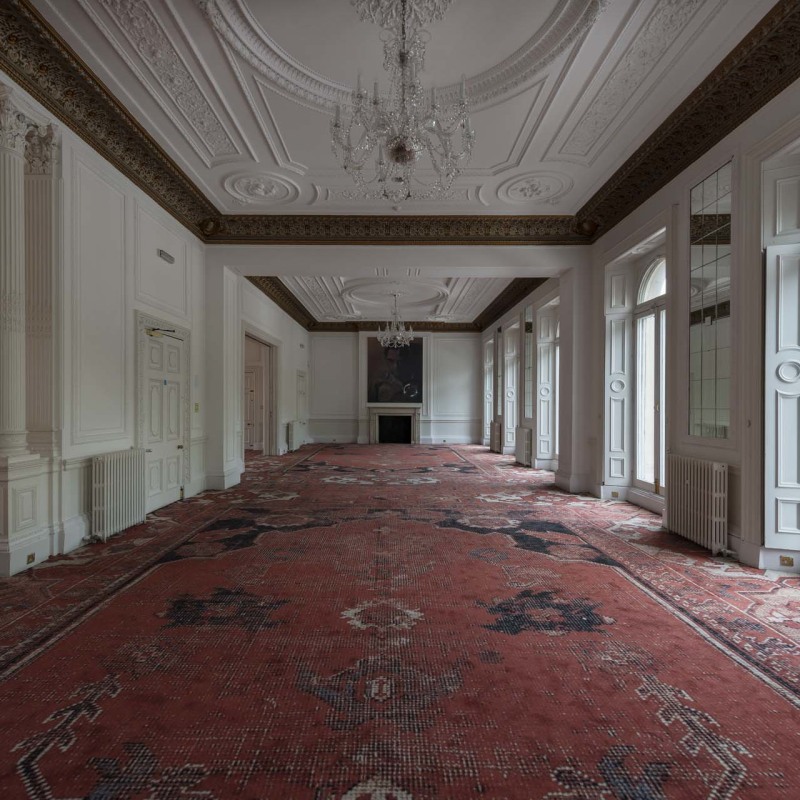Rudolf Stingel’s 2012 exhibition with Sadie Coles HQ takes place in a Grade II-listed Georgian townhouse whose interior looks back to French palatial architecture of the Renaissance. In the chandeliered first-floor ballroom, Stingel has installed a specially-designed carpet which spreads throughout the space. This site-specific installation is the latest in a twenty-year series in which the artist uses expansive carpets to dramatise and collapse the relationship between painting and its architectural contexts – for instance an orange plush carpet which covered a wall at the 1993 Venice Biennale, or PLAN B (2004), a kitsch floral design filling Grand Central Station in Manhattan.
For this exhibition, Stingel has reproduced a terracotta-coloured oriental design which chimes with – and magnifies – the opulence of the room’s tall windows, gold cornicing and chandeliers, while at the same time recalling the vast carpets of mosques. Yet its mechanical stitching and fitted format are at strange odds with its antique pattern, which evokes hand-woven and portable textiles. Moreover, the carpet’s granular appearance and fragmentary scheme make clear that it has been reproduced from composite digital images – as in a similar installation at Berlin’s Neue Nationalgalerie in 2010, sections have been repeated and variously magnified, and often end abruptly at the walls with no apparent concession to the proportions of the space.
Stingel therefore obscures any sense of an ‘original’ while retaining an unlikely aura of romantic opulence,which stands in contrast to the emptiness of the exhibition space. Like the artist’s room-sized installations of Celotex insulation board which visitors are invited to inscribe with graffiti, Stingel’s carpet introduces a participatory dimension to the exhibition. Visitors are inveigled into a horizontal picture plane – impelled both to survey and traverse the carpet, which muffles their footsteps while inducing an amplified selfconsciousness similar to that experienced in a sacred building. In contrast to the Celotex works, the traces they leave are faint and ephemeral. The process of walking on a surface is explicitly played out elsewhere in Stingel’s practice, notably in his series of works on Styrofoam, whose surfaces he has walked across in boots covered in lacquer thinner to leave trails of footprints.
Untitled (2012) hangs alone in an alcove in the manner of an altarpiece or devotional icon. This monumental self-portrait is painted from a photograph of Stingel illuminated by candlelight, which was taken by photographer Roland Bolego. Once again, there is a disjunction between the grand scale of the work and its content: the artist is shown unkempt and looking askance. In line with the other photorealist works Stingel has produced since 2005, the painting faithfully reproduces the discoloration and distress suffered by the photographic print on which it is based: ring marks and rips made by bottles are painted onto the surface, with Stingel’s image half-occluded beneath a wine-coloured film of underexposure and surface damage.
The layers of re-presentation at work in the painting (a hand-painted copy of a mechanically-produced portrait), invert the process of mediation compressed in the carpet, in which hand-woven designs have been mechanically enlarged and reprinted. But in both, there is a vivid sense of the imperfections inherent in translation and of the distortions wrought by time. These are manifested in the painting’s visible brushwork and at times impasto application of paint. Simultaneously in this work, Stingel’s career-long examination of painting – its contexts (both spatial and historical) and its limitations – merges with a sense of psychological self-examination or self-reckoning.
Rudolf Stingel was born in 1956 in Merano, Italy. He has exhibited internationally, with recent solo shows including those at Secession, Vienna (2012); and LIVE at the Neue National Galerie, Berlin (2010); and a major retrospective at the Museum of Contemporary Art, Chicago and the Whitney Museum of American Art, New York (2007). Other major solo shows include those at the Museum für Moderne Kunst, Frankfurt (2004) and the Museo d’Arte Moderna e Contemporanea, Trento, Italy (2001). His work has featured in group shows such as Mapping the Studio: Artists from the François Pinault Collection, Palazzo Grassi, Venice, Italy (2009); Day for Night: Whitney Biennial 2006, Whitney Museum of American Art, New York, and Universal Experience: Art, Life, and the Tourist’s Eye, Museum of Contemporary Art, Chicago, which travelled to the Hayward Gallery, London, 2005. His work was included in the 2003 and 1999 Venice Biennales. Rudolf Stingel lives and works in New York and Merano, Italy.
For further information please contact the gallery at +44 (0)20 7493 8611 or press@sadiecoles.com
